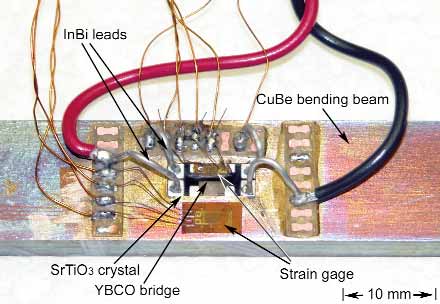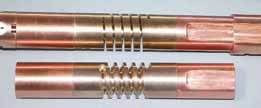| * |
|
Superconductor Electromechanics
Summary:The Magnetics Group's program in superconductor electromechanics measures the critical current of superconductor wires as a function of magnetic field, temperature, and mechanical strain, and investigates methods to improve the performance of high-temperature superconductors. Energy losses in the transmission of electricity from generation plants to cities amount to over 5 percent. Underground electrical distribution lines in cities are at the limits of their current-carrying capacities. These are examples of problems that could be mitigated with superconductors. The Superconductivity Program conducts enabling research in superconductivity for energy, power grid reliability, medical instruments, and fundamental physics. The program has a world-wide reputation for its measurements of the effects of mechanical strain and temperature on the ability of superconductor wires to carry extremely high current. Additionally, the program develops standard measurement techniques and international documentary standards for measurements to characterize superconductors. It provides quality assurance and reference data for commercial and prototype high-temperature and low-temperature superconductors.
Figure 2. Two copper-alloy spring sample holders.Superconductor wires are soldered to the outer circumference of the springs. Torque applied to the spring puts the wires into tension or compression.
Figure 3. Upper part of new high-current apparatus. The worm gear that is applied to torque the spring can be seen through the window.
Description:The global market for superconductors is about $5 billion, largely dominated by superconducting magnets for magnetic resonance imaging (MRI) machines. However, recent successful demonstration projects point to increasing applications in power transmission lines, fault current limiters, transformers, synchronous condensers, magnetic energy storage devices, and other components for the electrical power grid. Measurements to characterize superconductors require specialized expertise, and the measurements must be reliable in order to solve engineering problems that prevent wider use of both conventional and high-temperature superconductors.
 Figure 4. Critical-current measurement of a single of a single-crystal thin film of Y-Ba-Cu-O deposited on a SrTiO3 crystal. Axial compressive strain is applied by bending the beam Figure 4. Critical-current measurement of a single of a single-crystal thin film of Y-Ba-Cu-O deposited on a SrTiO3 crystal. Axial compressive strain is applied by bending the beamMajor Accomplishments:
Associated Publications/Reports:
|
 Figure 1. Unified apparatus for the measurement of superconductor critical-current density as a function of magnetic field, mechanical strain, and temperature. End Date:OngoingLead Organizational Unit:pmlStaff:Najib Cheggour
Cam Clickner
Loren Goodrich
Xifeng Lu
Ted Stauffer
Danko van der Laan
Contact
Loren Goodrich goodrich@boulder.nist.gov 325 Broadway
Previous Reports: Standards for Superconductor and Magnetic Measurements - Standards for Superconductor Characterization -
Superconductor Electromagnetic Measurements -
|


